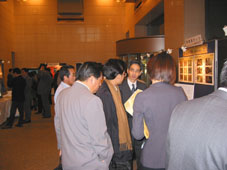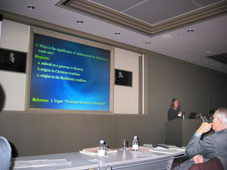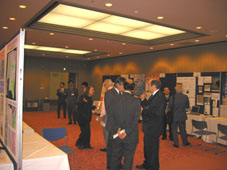
 |
|
The Tokyo Symposium for Digital Silk Roads was a great success. The Symposium was held from the 11th through the 13th of December 2001, under the co-sponsorships of UNESCO, the Japanese National Commission for UNESCO, and the National Institute of Informatics. Approximately 330 participants from all over the world took part in a lively discussion on the conservation and inheritance of Silk Road heritages as a new aspect of advanced digital technology. The programme was delivered with the themes of Past and Current Status on the first day, New Aspects on the second day, and Future Direction on the third day. Please refer to the PDF file for the detailed programme and speakers. The Symposium began with the Symposium Chair Prof. Ono as the moderator and opening ceremony addresses from Dr. Suematsu from the National Institute of Informatics, Mr. Shirakawa from the Japanese National Commission for UNESCO, the Ministry of Education, Culture, Sports, Science and Technology, and Dr. Khan from UNESCO. |
 |
 |
For the Keynote Address, Prof. Chie Nakane, former Chair of the Japanese National Commission for UNESCO, gave a lecture entitled 'People along Silk Roads and their Socio-cultural Interactions'. Dr. Abdul Waheed Khan, as the Assistant Director-General for Communication and Information of UNESCO, discussed his commitment to the cause of interdisciplinary cooperation in the effective applications of ICT in cultural heritage conservation. |
| Eight experts from the field of cultural and digital technology made the Review Address. They are as follows: Prof. Liang, Director-General, Institute of Scientific and Technical Information of China (ISTIC), Prof. Vatsyanyan, President of India International Centre, Ms. Guerreiro, Programme Specialist, UNESCO, Ms. Tashbaeva, National Academy of Sciences in Kyrgyzstan, Prof. Higuchi, Director, Research Center for Silkroadology, Mr. Karpov, Expert of Heritage Net, UNESCO-Almaty, Ms. Farahani, Iranian National Commission for UNESCO and Dr. Kamiuchi, General Manager for Strategic Products Development Center, HITACHI, Ltd. | |
|
Many participants visited the Exhibition Hall in the Atrium Lobby where seven companies and three organizations displayed products and services that utilized their advanced digital technology. Special sessions on the second and third day were for experts only and abstracts for these sessions were distributed in advance. Approximately 100 experts participated in these sessions each day. |
 |
 |
 |
|
| On the morning of the second day, new aspects such as digital conservation, excavation study, and identification of heritages using remote sensing were discussed. | In the afternoon, the discussion was based on the poster session created by 22 representatives of the participating countries, organizations, and companies. This was a great opportunity for the participants to exchange ideas and information. |
 |
On the morning of the third day, the future direction was discussed among the experts. The parallel panel session was held in the afternoon, where the Tokyo Declaration on Digital Silk Roads was discussed among UNESCO participants. Other participants discussed the future direction of the Digital Silk Roads under the theme of 'Where we are and Where we are headed'. Three days of active discussion and information exchange among experts from the cultural and technology fields of the world finally ended with the hope of enhancing the development of the preservation of the Silk Roads heritage in the future. Proceedings will be issued in February. Full papers of all presentations (including poster sessions) should be submitted to onostaff@nii.ac.jp until January 20th. |